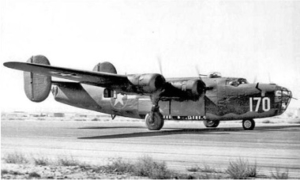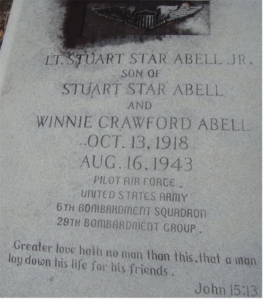Scroll of Honor – Stuart Star Abell, Jr.
Engine Failure
Written by: Kelly Durham
Stuart Star Abell, Jr. came to Clemson in 1936 from the Chester County crossroads  of Lowrys. A member of the Class of 1940, Abell attended Clemson for two years and majored in agriculture.
of Lowrys. A member of the Class of 1940, Abell attended Clemson for two years and majored in agriculture.
By the summer of 1943, with the world at war, Abell had entered military service, volunteered for the Army Air Force, and earned both his pilot’s wings and a second lieutenant’s commission.
In this era of a small, all-volunteer military, it is challenging to imagine the size and scale of the United States military that in mid-1943 was still growing at a rapid pace. New Army and Marine divisions were being activated, manned, and trained in preparation for the invasions still to come in both the Pacific and European theaters. Factories and shipyards were turning out tanks, ships, and aircraft at a previously unimagined rate. Training commands were tasked with preparing the young warriors who would ride these conveyances into battle.
Abell in that summer of 1943 was assigned to the 6th Squadron, 2nd Air Force based at Gowen Field near Boise, Idaho. Army Air Force training was gradually shifting. The activation of new bombardment groups and squadrons was slowing down, as more groups were being deployed to combat theaters. The need now was to train replacement pilots and aircrew members to replace combat losses. Airmen trained at Gowen would be shipped into existing bombardment groups in Europe or the Pacific after they completed their training on the types of aircraft they would crew in combat operations.
On the afternoon of August 16, 1943, Abell was assigned as the  copilot on a B-24E Liberator heavy bomber piloted by Second Lieutenant John W. Erb. The afternoon mission was a routine gunnery training flight. Five members of the ten-man crew of the big bomber manned fifty-caliber machine guns with which to protect their ship from enemy fighters. This would be another opportunity for these aerial gunners to hone their skills.
copilot on a B-24E Liberator heavy bomber piloted by Second Lieutenant John W. Erb. The afternoon mission was a routine gunnery training flight. Five members of the ten-man crew of the big bomber manned fifty-caliber machine guns with which to protect their ship from enemy fighters. This would be another opportunity for these aerial gunners to hone their skills.
The B-24 took off from runway 28E at 1639 hours in what at first appeared to be a normal takeoff. The landing gear was retracted and at about 600 feet above the ground the airplane began to slowly bank to the left. The bank quickly developed into a tight spiral as the airplane lost altitude and struck the ground nose-first.
The post-crash investigation revealed the pilot or copilot may have let the RPM on engines “#1 and #2 get too low when decreasing power after takeoff. As a result, it is possible that engine failure was encountered or that the pilot became confused and feathered #2 engine. In any event, the loss of power in #1 and #2 engines appears to have caused the ship to crash.” All ten aboard the aircraft were killed.
Abell was survived by his parents, a sister, and a brother. His remains were returned  to Lowrys where he was buried at Zion Presbyterian Church Cemetery.
to Lowrys where he was buried at Zion Presbyterian Church Cemetery.
For more information on Second Lieutenant Stuart Star Abell, Jr. see:
https://soh.alumni.clemson.edu/scroll/stuart-star-abell-jr/
For additional information about Clemson University’s Scroll of Honor visit:
